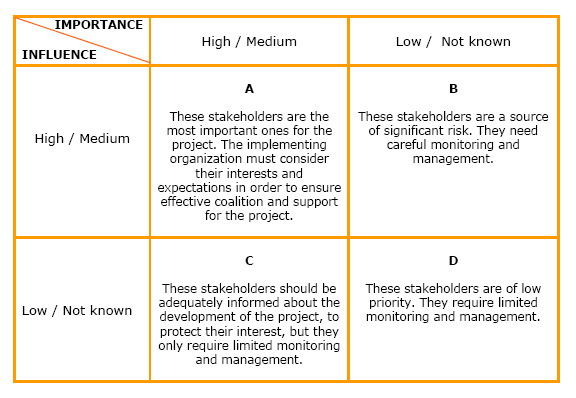Difference between revisions of "Stakeholder Analysis"
From Learning and training wiki
Ivana.dutli (Talk | contribs) |
|||
| Line 17: | Line 17: | ||
#'''Identifying major stakeholder groups:''' | #'''Identifying major stakeholder groups:''' | ||
#*Identify the groups that have a significant interest in the project (individuals, groups, communities, organizations, etc. ). | #*Identify the groups that have a significant interest in the project (individuals, groups, communities, organizations, etc. ). | ||
| − | #*Define the interests and agenda of the agency directing the exercise. This can be redressed later in the process by allowing the inclusion of more stakeholders as their interests | + | #*Define the interests and agenda of the agency directing the exercise. This can be redressed later in the process by allowing the inclusion of more stakeholders as their interests come to light. |
#'''Determining stakeholders' interests:''' | #'''Determining stakeholders' interests:''' | ||
#*Investigate roles, relative power and capacity to participate in the project, in order to draw out key interests for each stakeholder group. Key questions could include: | #*Investigate roles, relative power and capacity to participate in the project, in order to draw out key interests for each stakeholder group. Key questions could include: | ||
| − | #**What are the | + | #**What are the contributions the stakeholder can give to the project and what resources is it likely to commit (or avoid committing) to the project? |
#** What interests the stakeholder has in the project and what are the benefits it can get? | #** What interests the stakeholder has in the project and what are the benefits it can get? | ||
#** What are the stakeholder expectations and requirements to the project? | #** What are the stakeholder expectations and requirements to the project? | ||
Revision as of 12:46, 7 June 2010
| The identification of a project's key stakeholders, an assessment of their interests and the ways in which those interests affect project viability. A basic premise behind stakeholder analysis is that different groups have different concerns, capacities and interests, and that these need to be explicitly understood and recognized in the process of problem identification, objective setting and strategy selection. The key questions asked by stakeholder analysis are "Whose problems or opportunities are being analyzed" and "Who will benefit or loose-out, and how, from a proposed project intervention"? The ultimate aim being to help maximize the social, economic and institutional benefits of a project to target groups and ultimate beneficiaries, and to minimize its potential negative impacts, including stakeholder conflicts. A stakeholder analysis develops a strategic view of the social environment in which a project will be implemented, thus it is usually the first step in building the relationships needed for the success of a project. A stakeholder analysis can be undertaken throughout all the stages of a project cycle. It can be used to:
|
Step by Step
Stakeholder MatrixA stakeholder matrix allows for stakeholders to be plotted against different variables, taking into consideration their importance and their level of influence in the project. [3]
Job Aid |
References
- ↑ www.landcareresearch.co.nz (23 July 2008), www.panda.org (23 July 2008); Aid Delivery Methods - Project Cycle Management Guidelines, European Commission, 2004
- ↑ www.euforic.org (14 August 2008), www.landcarersearch.co.nz (14 August 2008), www.who.int (14 August 2008), Project Cycle Management Guidelines, European Commission, 2004
- ↑ www.dse.vic.gov.au (14 August 2008)www.who.int (14 August 2008)
